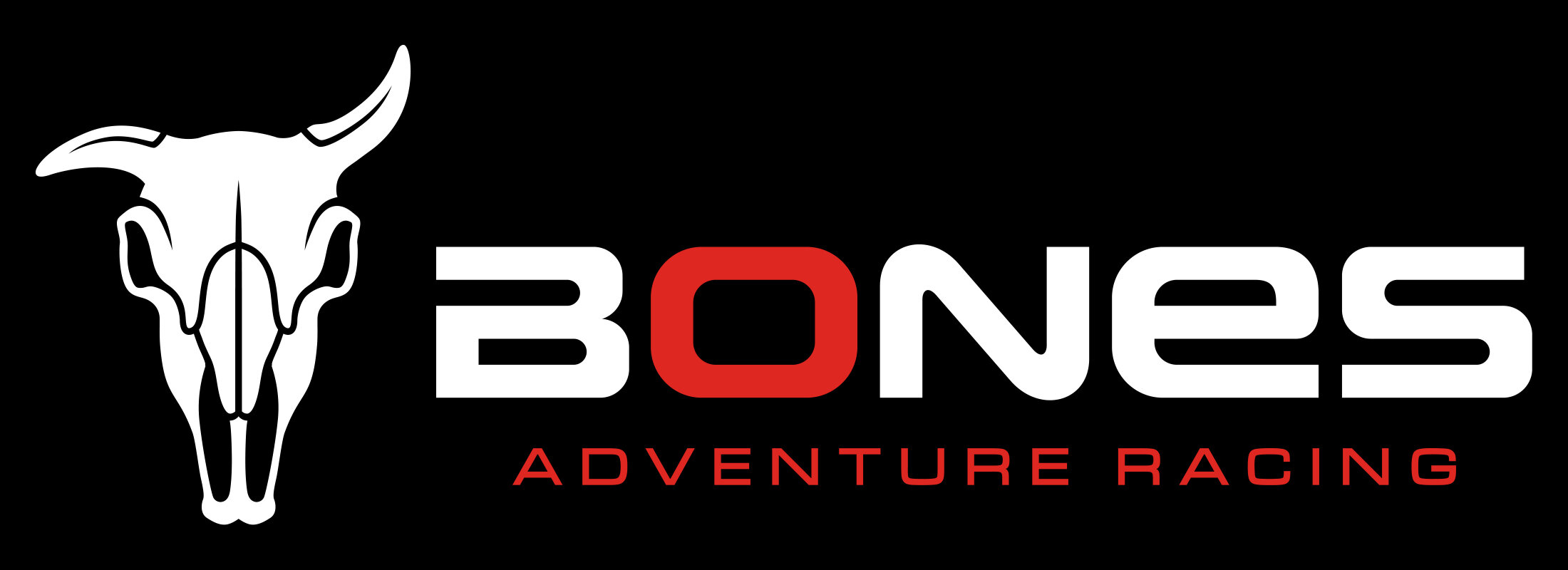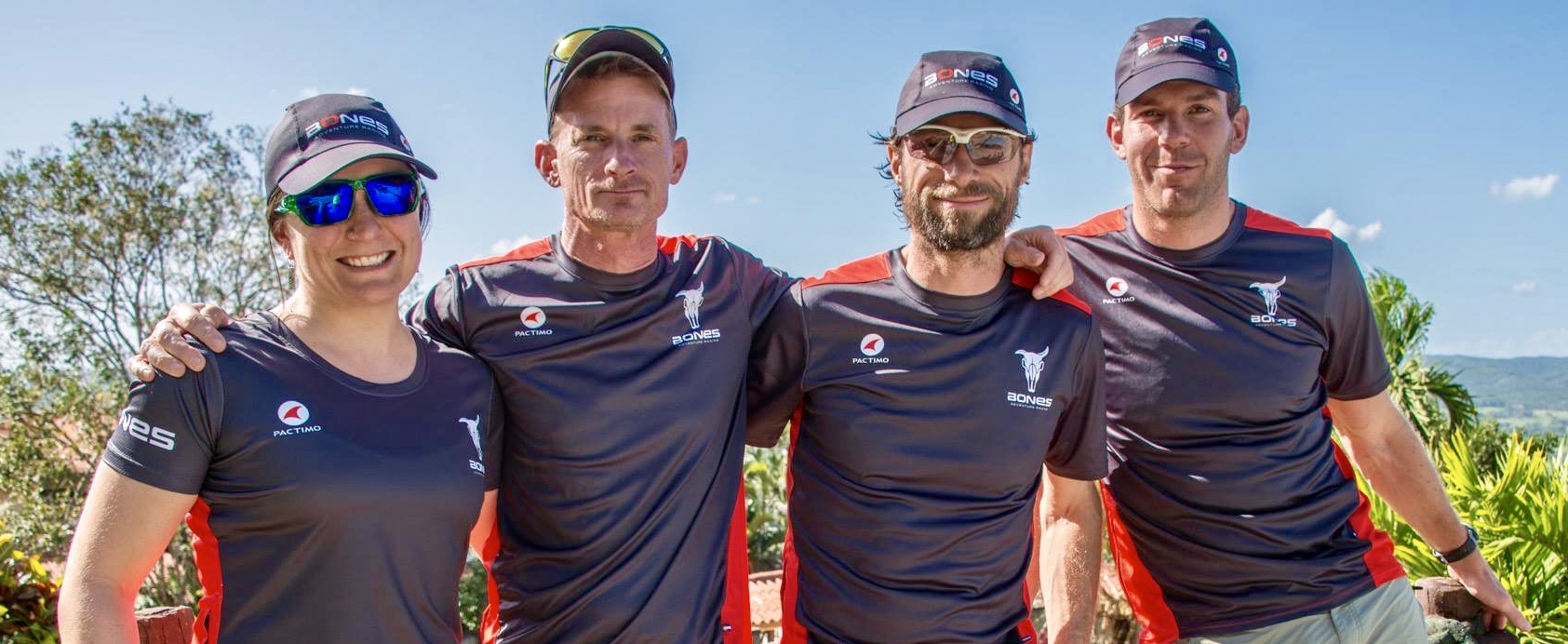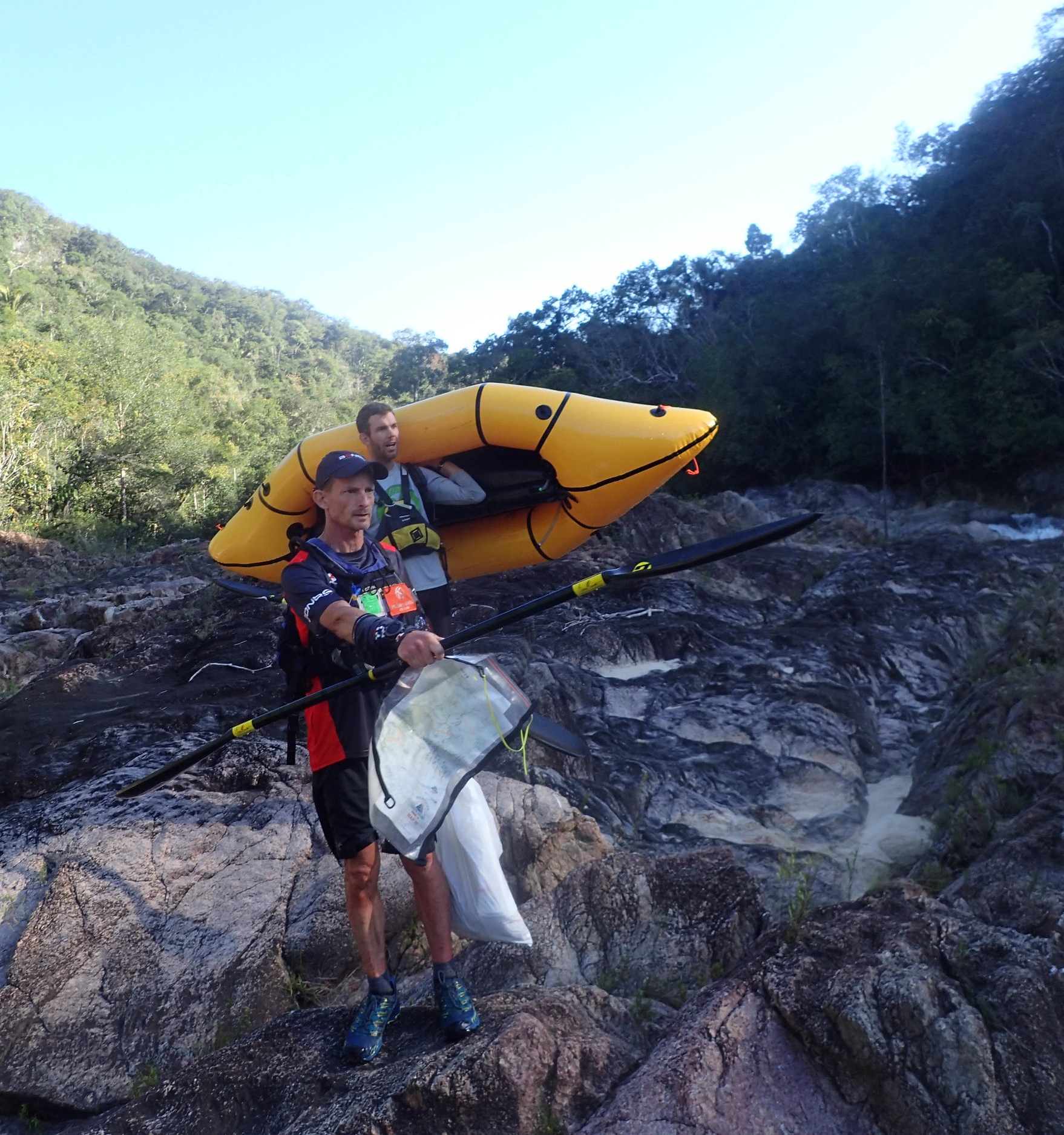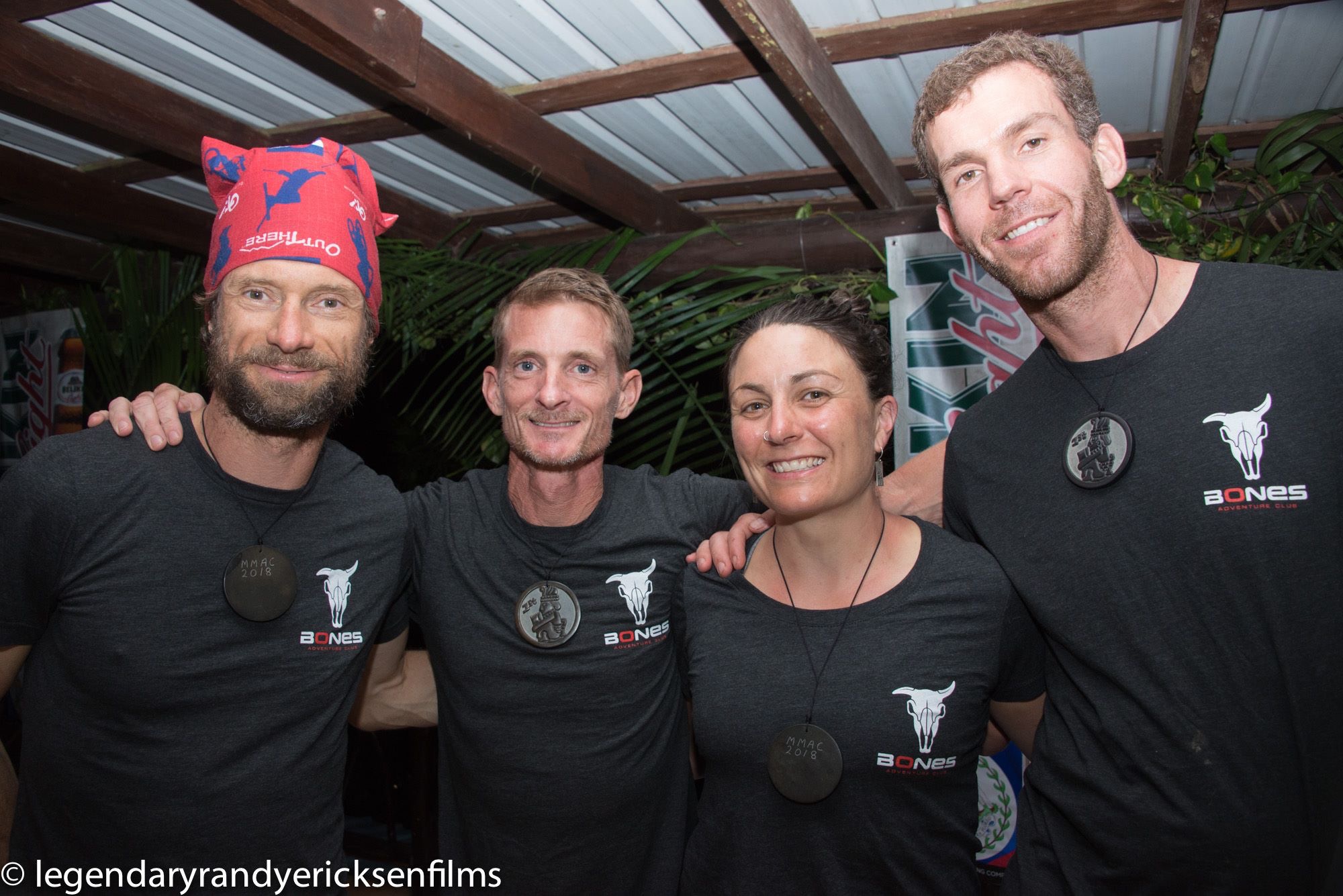2018 | ARWS Maya Mountain Adventure Challenge
The things you hear during a four-day race in the jungle……
"My toe just de-sheathed"
"Whoa! A boa constrictor!"
"We should get sponsored by Immodium"
"What are those black things on your legs!?!"
"Damn, those French are fast"
"The chaffing is amazing"
"This jungle path goes nowhere"
"Oh, Canada"
Bones Adventure Racing kicked off the 2018 racing season with the Maya Mountain Adventure Challenge, in Belize- a Central American country south of Mexico and east of Guatemala. At only 68 miles wide, we were able to start near the Guatemala border and transverse east all the way to the coast before returning along a more southern route. Long a British Colony, Belize was granted independence in 1981, despite protestations from Guatemala that Belize actually belongs to Guatemala. That dispute continues to this day.
Photo credit: Randy Ericksen
The team consisted of Roy Malone and Jen Segger, who had raced together last at Bones' 8th place finish at the 2016 World Championships, Aaron Rinn and Chad Spence- both new to the team, but very experienced racers. Our goal was a podium finish, but we knew there were several very strong European teams competing, including #4 ranked Naturex from France, who had beaten us by a couple of hours the last time we had raced against them in Australia, Agde Raid Adventure and AdeoRun- both from France, and Powerbar Swiss Explorer from Switzerland.
A preview of the course was given to each of the teams a few days before the race began to help teams pack properly and think strategically about the upcoming 310+ miles in the jungle. Our initial assessment? Despite the relatively flat terrain of central and eastern Belize, the predicted 2.5 to 3-day winning time looked a bit optimistic to us. It was.
"The Prologue"- (Stages 1-4)
We viewed the first four stages in much the same way we would a long prologue. The goal was to be at the pointy end of the leaderboard, be efficient, learn the map, and not blow ourselves up in the heat early in the race. The end of stage four also had a dark zone, so any extra time accumulated here through extra effort would be "lost" to a mass 5 AM start for any team who made it in before then.
Stage 1
22-mile canoe paddle
The Belizian furnace was turned up high as we pushed off at noon on Sunday. We, along with Naturex and French Team Agde Raid Adventure, were able to break from the pack and settle into a rotation of leading or drafting. The train of six canoes arrived at TA1 within a minute of each other, 3.5 hours after the start.
Stage 2
38-mile mountain bike
The two French teams had lightning fast transitions and left quickly. Our first transition as a new team left much to be improved upon, which we vowed to do as the race progressed. Then we promptly had two mechanical bike problems.
The first 24 hours of an expedition race is a funny thing. Seconds or minutes lost here can feel catastrophic- like they are impossible to make up. We historically have tried to not stress about these issues and remember that later in a race is where a lot of time can be made up as the pace slows. Clear thinking and efficiency can more than make up for losses due to haste. Still, as early race adrenaline rages, keeping calm is tough.
After repairs, we rode efficiently and our route choice was conservative. We stuck to a slightly longer route, but on gravel roads- not braving what appeared to be a shorter trail. We wanted to get a feel for the 1:50,000 scale maps and how closely they matched the terrain before we were willing to take route risks. Somewhere during the stage, where we could tag three controls in any order, we were able to get a short lead heading into the third stage.
Stage 3
22-mile canoe paddle (again)
We returned to the canoes that we had left a few hours earlier with instructions to load our bikes into the canoes for the next paddle. It was dark now and a low mist was starting to wisp from the river- making it difficult to see and avoid hazards. We set a strong pace knowing Naturex was only a couple minutes behind and managed to hold the lead (and avoid the debris in the river) to stage four. Unfortunately for Team Powerbar Swiss Explorer, they capsized one of their canoes, which sunk and carried their two attached bikes along. Fortunately, they were eventually rescued as were their bikes the next morning and to their credit continued on with the race.
Stage 4
26-mile mountain bike
This section was relatively short but navigationally tricky as there was a point where we had to cross a river in the middle of an orchard with no trails and darkness limiting our landmarks. Fortunately, Chad and Aaron nailed the bend in the river and we were able to progress to the other side, which connected us to a series of gravel roads and multiple paths to stage 5- the crux of the race – still in the lead, but with Naturex hot on our wheels as evidenced by the chorus of dogs who would announce each team's passing with incessant barking. We finished with enough time for a short 1-hour sleep before the dark zone restart at 5:00 AM. "Sleep" is a relative term here as we were only 16 hours into the race and our bodies weren't ready for a break- yet.
"The Crux" (Stages 5-6)
As we were mapping this section after receiving the pre-race packet, we figured that this would be where big gains or losses would occur. A long trek with multiple disciplines, followed by a really long mountain bike back-to-back, would serve as the opportunity make or break a team's race.
Stage 5
37 miles trekking, ropes, cave swim
The packs were HEAVY as we left for what we thought would be 14+ hours on the trail. Climbing gear, PFD, swim gear and food/water for the trip. "Damn, those French are fast!". While we both left at 5:00 AM, Naturex pushed hard to get to the rappel before us. It was impressive how fast they ran with heavy packs. We weren't far behind though and ended up catching them as we hit the ropes. After an amazing 400-foot free hanging rappel to the bottom of a massive sinkhole, we scrambled back up and out – Naturex once again right on our heels. Not for long though as they passed us again during the 8-km run to the cave swim.
We caught back up as they headed into the 5km cave section. We had been advised that much of the cave system would be walkable, with a few swim sections. Once in the caves, it was evident that the unusual month-long rains that preceded the race, created a much deeper swim section and we ended up swimming for almost half of this section. We would subsequently trade places with Naturex for the first 20 minutes until they stopped and took out their secret weapons - floaties! While it took them a bit to blow them up, they blew right by us and were hooting and hollering, having a good time while we fumed and plodded along with the breast stroke and hand paddles. Why hadn't we considered those??
The underground cave network is incredible. Ian Anderson's Caves Branch runs tours there if anyone is interested in a trip to Belize. As is the rappel, which they also host. Go do it.
The rest of the day was spent running, finally getting to a jungle trail that was "marked" by the occasional blaze on a tree or the rare orange flagging. This was not a place you wanted to get lost or go off trail. It was wet and sloppy. Footing was tough and it was slow going. After crossing a river that we had been following for hours, we lost the trail. We knew where we were, and where the trail should be but couldn't locate where it began again. Frustrations mounted as all of us poked and explored alternatives. After 90 minutes, we resolutely opted to bear due west to a gravel road that would take us out and around to the next control, albeit at 3X the distance. We were dispirited thinking Naturex had gotten away from us.
Nearing the control, we saw Naturex jogging toward us- four headlamps bobbing along. It was game back on. Evidently, all of the teams had the same challenge and ended up taking that option, except Team Mexico Cemac Toluca, who somehow managed to locate it. Much respect.
As we finished the stage, Naturex was busy getting ready to leave, having slept while we were wrapping it up. Our projected time of around 14 hours ended up taking over 19. Bruised and tired, we opted for a 1: 45-hour sleep- and went deep!
Stage 6
78-mile mountain biking
During the transition on this stage, we realized we made a terrible mistake. Not wanting to carry all 17 maps with us the whole race, we had stored half in Bin B ready to be picked up in time to use them. Unfortunately, we wouldn't see Bin B until the END of Stage 6- not the beginning and thus had no biking maps. What to do? We were fortunate to prevail upon the kindness of Team Belize Grisons who were in the same TA on a shorter course who allowed us to photograph their maps with Aaron's mandatory camera.
Excited by being on paved asphalt, we hit the road hard…. and ended up blowing way past the first control of this leg. Backtracking is never fun, but when it's on the front end of a massive bike leg, it's even harder. No team drama though, we knocked it out and got back on track. Shortly after the paved section, we needed to follow a river, which consisted of random village paths, animal trails and mostly no tracks. Often the best route was walking in and down the river. It was slow and often required backtracking to find the best route. Trying to navigate a 1:50,000 scale on a 2X3 inch camera screen made it that much tougher. We were beginning to lose some serious time to Naturex.
Once past the river, we had a long leg to Davis Falls. An out and back on foot for an hour in bike shoes to get to the base, and a return to the gravel roads. On our way out, we almost ran over a six-foot boa snake meandering across the trail. Thick as a water bottle, it was an imposing reptile, but like most of the wildlife we saw this race, wanted nothing to do with us. A quick snapshot and we were off.
Upon regaining the road, it was heads down- busting out the remaining miles on mostly flat gravel roads.
Stage 7
19-mile trek
Typically, in an expedition race, when there are two monster sections like #5 and #6 back-to-back, race management creates a recovery leg. On the map, stage 7 appeared to be that leg. It looked like a straight forward mix of road and single-track which would route us to the final mountain biking section of the race.
It was dark. We packed to travel light and fast- food for six hours, shorts, minimal water. The hour to the first control was, in fact, a fast gravel road. We made quick work of it and then decided to nap for 30 minutes as we hadn't slept since the end of the first long trek almost 24 hours prior. Little did we know that Naturex was currently circling not far from where we slept.
The entry into the jungle was not immediate. It was dark and slow, and we followed a very wet and muddy overgrown path which ultimately took us further and darker into the mess. Eventually, we were trying to follow machete cuts. No clear trail was evident and a systematic effort of route finding meant someone would take the lead until it dead-ended, and then we would spread out to find a new path forward and someone new would lead- all while trying to keep an SW bearing. This rotation kept us fresh and we made constant (although slow) progress.
The mud underfoot was tenacious, often up to our knees. Mosquitos and Botlass Flies were constant companions. The Botlass Fly was particularly obnoxious as it would use its serrated jaws to cut micro capillaries and then drink our blood, nourishing its eggs. Smart little buggars too- they would land on the backs of our arms and legs where we couldn't see them. Long pants and shirts would have been smart here.
After many hours of slow progress, where we often found ourselves backtracking and then circling back, we finally punched out to the "road". While represented as a road on the map, it wasn't much more than a jungle trail without the jungle. If anything, the mud was even worse. It was still dark, and by this time we were starting to lose our focus and motivation. Our travel south along the road should have taken us directly to the next control, but it was nowhere to be found.
We knew exactly where we were, and after several attempts and about an hour back and forth along the road, trying to locate the flag, we took a picture of where it should have been and proceeded west along the next jungle trail (after the race, we found out that the flag had been placed about 3km south of where it should have been). After a few more hours of jungle travel, we at last punched out on to a dry, hard gravel road and tried to push and finish the leg. We knew we'd be tight on time for the upcoming dark zone cutoff. Our "recovery" stage #7 ended up taking us almost double our expected time. We weren't feeling very recovered.
Stage 8
40-mile mountain bike
We arrived at the transition area to find out that we had somehow passed Naturex in the jungle. It was almost 10:00 AM and if we could get to control 26 by 1:30 PM, we wouldn't be caught the dark zone, would be able to proceed to the finish, and likely be able to win. The next 40 miles on the bike was a hard push along gravel roads and hilly terrain during the middle of the hottest day of the race.
Our internal thermometers were pushing high as we gave it all we had to get there in time. As the miles and minutes ticked away, it looked like it would be close. Everyone gave it everything. In the end, we missed it by 12 minutes. We were a bit shattered as we rolled into control 26, knowing that our lead tomorrow morning would only be as much as the time difference between ourselves and when Naturex would arrive. We also knew we left nothing on that leg. Our effort would have to stand. We settled into an eat, sleep, eat, sleep pattern until the 3:00 AM start of the last leg to the finish line.
Stage 9
22 miles trekking, canyoneering, packrafting
As we woke to prepare for the last leg, we were told that Naturex had come in about 1:00 AM, which meant that we had a fairly comfortable lead. Barring any major mistakes, mechanical issues (like a popped packraft), or injuries or illness, we had a good shot. In adventure racing, however, anything can and often does happen, so we weren't taking any chances. At 3:00 AM sharp we took off at a smart clip and kept pushing like prey.
Despite a few flips in the whitewater packrafting section, we managed to move efficiently and finish the long 18 km paddle listening to an awful rendition of "Oh, Canada" from Aaron and Jen's boat. Highlights included watching a monster iguana swim across the river right in front of us.
Stage 10
Final trek to the finish line
After four days in remote jungles, savannah, and countryside, the psyche isn't quite ready for the hustle and bustle of everyday life. The last 2kms wove through a typical Thursday afternoon in San Ignacio with all of its traffic, commerce, and general business activity. Dodging cars, feisty dogs, and curious pedestrians somehow seemed more dangerous than the wildlife that we'd just spend the past few days with.
The Finish
While it’s great to win, the best part of any race is really the sense of accomplishment.
Photo credit: Randy Ericsen
It's the bond that's created when four people overcome challenges, problem solve, manage the emotions brought about by fatigue and sleep deprivation, and act as a single perpetual unit during the race to accomplish something that could never be achieved alone.
That is what brings so many of us back to the starting line again, and again. Despite the pain. Despite the suffering. Despite the bruises, lost skin, and toenails. That bond, once formed, can achieve incredible things and the dopamine that comes from it fuels the pursuit for more.
I'm honored to have raced my teammates- three fine athletes and even better people: Jen Segger, Aaron Rinn, and Chad Spence. Regardless of what life throws our way, we know there is a bond between us, a camaraderie, that can be called upon whenever needed.
Last thoughts:
Putting on an expedition length race, especially in a foreign country, is hard work. Permits, scouting, communications with land owners, government officials, logistics. It's definitely a work of passion, not profit. Doug and Julia put on an amazing expedition for the twelve teams that were fortunate to compete in Belize this year. As racers, we should be so thankful that we have fellow adventurers who are so passionate about showing off a little part of the world, that they are willing to put that amount of energy into creating an adventure for us to test ourselves in. This race required more than speed and strength. It required strategy, tactics, tenacity, presumption, adaptation. It required us to use our soft skills when speed alone wouldn't cut it- like a true expedition. A HUGE thank you to them and their amazing team of volunteers for letting us play in their tropical paradise.
Lastly, a brief note about Belize. The people are amazing. Always a smile, wave, or positive salutation. Even when trespassing their property at 2:00 AM, we never met any angry or upset locals. Try that in most parts of the world. Thank you to the people of Belize.
Until next time…..











